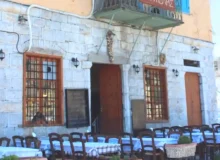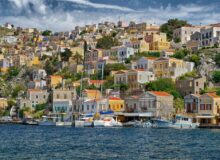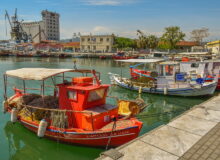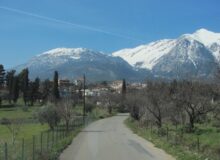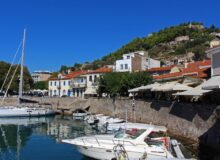The See Greece guide to the island of Lipsi with a brief history and travel information on how to get there by ferry or by air and what to see and do.

Introduction to Lipsi
Lipsi is a small, unspoiled island in the Dodecanese, known for its tranquil atmosphere, crystal-clear waters, and charming traditional character. Unlike some of its more famous neighbors, Lipsi remains relatively untouched by mass tourism, making it an ideal destination for travelers seeking an authentic Greek island experience. This guide covers everything you need to know about Lipsi, including its location, history, top attractions, the best time to visit, and how to get there.
Where is Lipsi Located?

Lipsi is part of the Dodecanese island group in the southeastern Aegean Sea. It lies between the larger islands of Patmos to the north and Leros to the south, with Kalymnos and Kos further to the southeast. The island is small, covering just about 8 square miles (21 square kilometers), and has a population of around 800 residents. Despite its size, Lipsi boasts beautiful beaches, scenic landscapes, and a relaxed way of life that draws visitors looking for peace and natural beauty.
A Brief History of Lipsi
Lipsi’s history is intertwined with that of the Dodecanese islands, which have been influenced by various civilizations over the centuries. The island’s name is believed to derive from “Lipsos,” a mythical figure mentioned in Homer’s Odyssey. Archaeological findings suggest that Lipsi was inhabited in ancient times, possibly by the Carians or the Dorians.
During the Byzantine era, Lipsi was a minor settlement, and later, like much of the Dodecanese, it came under the control of the Knights of St. John in the 14th century. The Ottomans ruled the island from the 16th century until 1912, when Italy took over. After World War II, Lipsi, along with the rest of the Dodecanese, officially became part of Greece in 1948.
Today, Lipsi retains a traditional character, with whitewashed houses, small family-run tavernas, and a strong connection to its maritime heritage.

What to See and Do on Lipsi
1. Explore Lipsi Town (Chora)
The island’s main village, Lipsi Town (also called Chora), is a picturesque settlement with narrow streets, whitewashed houses, and vibrant bougainvillea. Here, you’ll find:
– The Church of Agios Ioannis Theologos – The island’s main church, housing a revered icon of the Virgin Mary.
– The Ecclesiastical Museum – A small museum displaying religious artifacts, icons, and historical items.
– Local Tavernas and Cafés – Enjoy fresh seafood, traditional Greek dishes, and the island’s famous honey and wine.
2. Visit the Beaches
Lipsi has several beautiful beaches with clear waters, perfect for swimming and relaxation. Some of the best include:
– Platis Gialos – The most popular sandy beach, with shallow waters ideal for families.
– Kampos Beach – A quieter pebble beach with a small taverna nearby.
– Hohlakoura Beach – A secluded spot with turquoise waters, accessible by boat or a short hike.
– Tourkomnima Beach – A small, peaceful beach surrounded by rocky cliffs.
3. Take a Boat Trip to Nearby Islets
Lipsi is surrounded by small uninhabited islets, many of which can be visited by boat. Highlights include:
– Aspronisia and Makronisi – Known for their pristine waters and excellent snorkeling spots.
– Lipsi’s Marine Cave (Spilia tis Panagias) – A stunning sea cave accessible by boat.

4. Discover the Walking Trails
For those who enjoy hiking, Lipsi offers scenic trails leading to secluded beaches, chapels, and viewpoints. A popular route is the walk from Chora to Kimisi tis Theotokou Church, which offers panoramic views of the island.
5. Taste Local Products
Lipsi is known for its:
– Honey – Produced from thyme and wildflowers.
– Wine – The island has a small winery producing unique local varieties.
– Cheese – Try the traditional mizithra and feta.

Best Time to Visit Lipsi
The best time to visit Lipsi depends on your preferences:
– May to June – Ideal for warm weather, blooming landscapes, and fewer crowds.
– July to August – Peak season with the hottest temperatures and lively atmosphere (though still quieter than larger islands).
– September to October – Perfect for pleasant weather, warm seas, and a more relaxed vibe.
Winters are very quiet, with some businesses closing, making it less suitable for tourism unless you seek complete solitude.

How to Get to Lipsi
By Air
Lipsi does not have its own airport. The nearest airports are:
– Leros Island National Airport (LRS) – About 1 hour by ferry from Lipsi.
– Kalymnos Island National Airport (JKL) – Around 2 hours by ferry.
– Kos Island International Airport (KGS) – Approximately 3-4 hours by ferry.
From these airports, you can take a taxi or bus to the port and then a ferry to Lipsi.
By Ferry
Lipsi is well-connected by ferry, especially in the summer months. Key routes include:
– From Piraeus (Athens) – Overnight ferries (approx. 9-11 hours) operated by companies like Blue Star Ferries.
– From Other Dodecanese Islands – Regular connections from Patmos, Leros, Kalymnos, Kos, and Rhodes.
– From Samos and Ikaria – Seasonal routes may be available.
Ferry schedules vary by season, so it’s best to check with operators like Dodekanisos Seaways or Blue Star Ferries for up-to-date timetables.

Final Tips for Visiting Lipsi
– Cash is King – While some places accept cards, smaller businesses may prefer cash.
– Rent a Scooter or ATV – The best way to explore the island independently.
– Pack Light – Lipsi’s relaxed vibe calls for casual clothing, swimwear, and comfortable shoes for walking.
– Respect Local Customs – Dress modestly when visiting churches.















